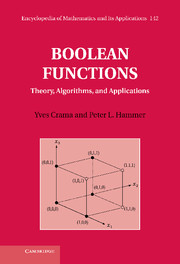Book contents
13 - Pseudo-Boolean functions
from Part III - Generalizations
Published online by Cambridge University Press: 01 June 2011
Summary
Definitions and examples
In Chapter 1, we defined a pseudo-Boolean function to be a mapping from Bn = {0,1}n to ℝ. In other words, a pseudo-Boolean function is a real-valued function of a finite number of 0–1 variables. Identifying the Boolean symbols 0 and 1 (or T and F, Yes and No, etc.) with the corresponding integers, we see that pseudo-Boolean functions provide a proper generalization of Boolean functions. In fact, just as in the Boolean case, the deliberate ambiguity that results from this identification rarely causes any difficulties, but it is frequently the source of fruitful developments.
The systematic investigation of pseudo-Boolean functions, their theoretical properties, and their applications has been initiated by Hammer and Rudeanu in [460], building on previous ideas of Fortet [342, 343] and of Hammer, Rosenberg, and Rudeanu [458]. This field of research has given rise to countless subsequent publications over the last decades.
Since the element of {0,1}n are in one-to-one correspondence with the subsets of N = {1, 2, …, n}, every pseudo-Boolean function can also be viewed as a real-valued set function defined on P(N), the power set of N = {1, 2, …, n}. Set functions have been extensively studied because of their mathematical appeal and their presence in numerous fundamental models of mathematics and of applied sciences. By considering functions defined on {0,1}n rather than on P(N), however, the pseudo-Boolean approach provides an algebraic viewpoint, which sometimes carries clear advantages over the set-theoretic description.
- Type
- Chapter
- Information
- Boolean FunctionsTheory, Algorithms, and Applications, pp. 564 - 608Publisher: Cambridge University PressPrint publication year: 2011



